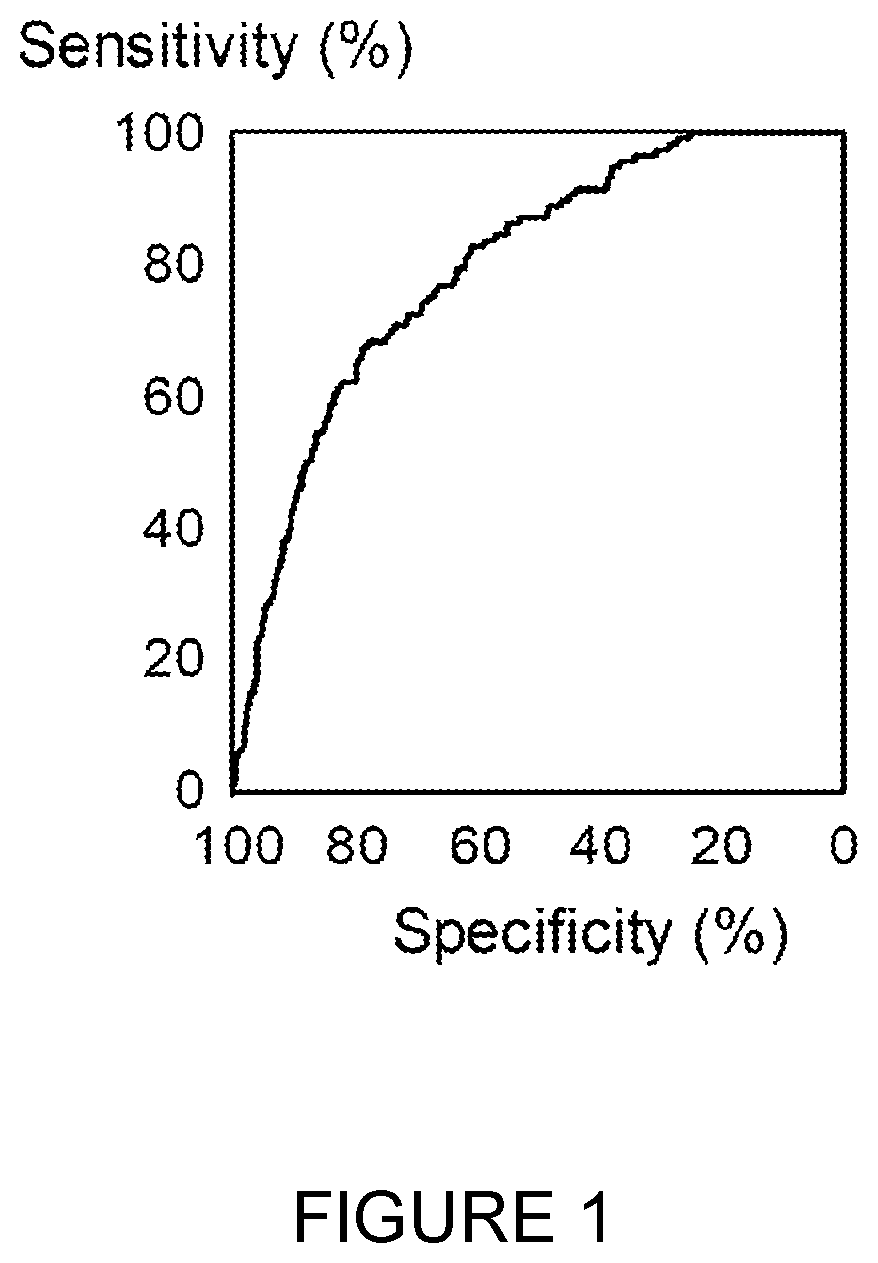Combination test for colorectal cancer
a colorectal cancer and combination test technology, applied in the field of colorectal cancer screening, can solve the problems of early treatment and many years of saving life, and the methods commonly used for crc detection and/or screening suffer from major drawbacks
- Summary
- Abstract
- Description
- Claims
- Application Information
AI Technical Summary
Benefits of technology
Problems solved by technology
Method used
Image
Examples
example 1
[0229]1907 persons who tested positive in a FIT (fecal occult blood) test and were for this reason referred for a colonoscopy gave informed consent for giving a blood sample and for anonymous use of patient data. The blood samples were taken prior to colonoscopy and analysed using a number of assays for cell-free nucleosomes including nucleosomes per se, and nucleosomes containing the epigenetic features of 5-methylcytosine modified DNA, histone variants H2AZ and mH2A1.1, histone modifications pH2AX, H2AK119Ub, H3K36Me3, H4K20Me3, H4PanAc and H3S10Ph and the nucleosome adducts nucleosome-HMGB1 and nucleosome-EZH2.
[0230]All of these nucleosome assays were useful for methods of the invention. The results for one panel involving 5 nucleosome assays (5-methylcytosine, H2AK119Ub, pH2AX, H3K36Me3 and nucleosome-HMGB1 adduct) together with the person's numerical FIT level and age for the identification of CRC cases against cases with no findings on colonoscopy are shown in the ROC curve in...
example 2
[0231]1907 persons who tested positive in a FIT (fecal occult blood) test and were for this reason referred for a colonoscopy gave informed consent for anonymous use of patient data. For each person their fecal haemoglobin (Hb) level, in μg Hb / g feces, and the age of the patient in years were entered into the expression:
0.0129×FIT LEVEL (μg Hb / g feces)+0.0688×AGE (yrs)
[0232]If the output value of the expression was greater than 4.8 then the patient was assigned as high risk for CRC and in need of a colonoscopy. Correspondingly, if the output value of the expression was less than 4.8 then the patient was assigned as low risk for CRC and not in need of a colonoscopy.
[0233]Of 118 diagnosed cases of CRC, 114 were correctly assigned as in need of a colonoscopy using this method. Similarly, 222 of 252 cases of High Risk Adenoma (88.1%) were correctly assigned as in need of a colonoscopy. The ROC curve shows that at a specificity of 25% the sensitivity of the method for CRC is above 95%. T...
example 3
[0234]599 persons who tested positive in a FIT (fecal occult blood) test and were for this reason referred for a colonoscopy gave informed consent for giving a blood sample and for anonymous use of patient data. The blood samples were taken prior to colonoscopy and analysed for ferritin and CEA. The assay results in combination with the patient's age and numerical FIT results were entered into the expression;
0.51×AGE (yrs)+0.17×CEA (ng / ml)−17.85×(5×FIT)−0.1 (μg Hb / g feces)−0.17×FERRITIN (ng / ml)
[0235]This expression was set to provide a 25% reduction in colonoscopy referral. If the output value of the expression was greater than −8.6 then the patient was assigned as high risk for CRC and in need of a colonoscopy. Correspondingly, if the output value of the expression was less than −8.6 then the patient was assigned as low risk for CRC and not in need of a colonoscopy. Of 118 diagnosed cases of CRC, 116 were correctly assigned as in need of a colonoscopy using this method of the inven...
PUM
| Property | Measurement | Unit |
|---|---|---|
| Time | aaaaa | aaaaa |
| Time | aaaaa | aaaaa |
| Time | aaaaa | aaaaa |
Abstract
Description
Claims
Application Information
 Login to View More
Login to View More - R&D
- Intellectual Property
- Life Sciences
- Materials
- Tech Scout
- Unparalleled Data Quality
- Higher Quality Content
- 60% Fewer Hallucinations
Browse by: Latest US Patents, China's latest patents, Technical Efficacy Thesaurus, Application Domain, Technology Topic, Popular Technical Reports.
© 2025 PatSnap. All rights reserved.Legal|Privacy policy|Modern Slavery Act Transparency Statement|Sitemap|About US| Contact US: help@patsnap.com

